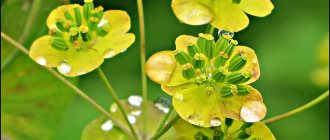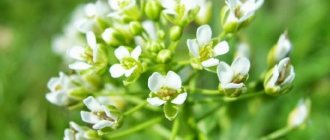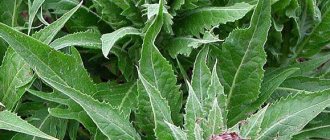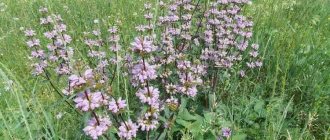What does eryngium grass look like - description, photo, varieties
Eryngium (Eryngium) is not one separate species, but a genus that belongs to the Umbrella family.
Its species have a similar botanical description. It is a perennial herbaceous plant with a straight bluish stem up to 0.5 m in height. The flowers are small, blue-blue in color, and the leaves are elongated and have an irregular geometric shape.
Flat-leaved (flat)
Grows in central Russia and the south of Russia. Used for medicinal purposes.
Field (plain)
Distribution area: steppes and plains of Europe. The flowers range from white to a slightly bluish hue.
Alpine
In an uncultivated state it grows in the Alps and the Balkans. Considered for decorative purposes.
Barbed
Named for the spiky teeth on the flower. Grows in temperate climates.
Seaside
Grows in Europe and North Africa. Place of growth - dunes on sea coasts.
Caucasian
Externally similar to other types, however, it is endemic to the Caucasus region.
Amethyst
Grows in Southern Europe. High decorative value, found application in landscape design.
Growing eryngium from seeds
Sowing eryngium
Eryngium can be easily propagated by seed. Seeds are planted immediately in open ground. The most favorable time is spring.
- Seeds are placed in two centimeter depressions.
- An interval of up to 0.5 m is left between the rows.
- The holes between sowings should also be placed at a distance of 50 cm. Otherwise, thinning of the seedlings will be necessary.
The eryngium can also reproduce by self-sowing - the seeds can fall into the ground on their own, and sprouts will appear from them in the spring. To provide the necessary conditions for full development, they should be thinned out. The eryngium does not require special care. But weeding and watering are simply necessary. The crop grows very quickly, the roots penetrate deeply into the soil.
Eryngium seedlings
Some gardeners pre-germinate seedlings from seeds. This procedure usually begins at the end of winter. Then by May the young plants will be ready for transplanting into open soil.
- The seeds are sown in a prepared tray with universal soil. Do not load grains deeply. 40-50 cm is enough.
- The crops are covered with film until shoots appear. Then the covering is removed. The air temperature should be 20 degrees. The lighting is preferably bright, but diffused.
- Sprouts require moderate watering.
- If the shoots are crowded, they are transferred to larger pots, where they remain until planted in open ground. The procedure is carried out at the end of May, but the seedlings are hardened off for a couple of weeks beforehand, for which they are regularly taken out into the fresh air.
- When transplanting into the ground, the seedling is simply transferred along with a lump of earth into the prepared hole. The distance between plantings is 40 cm. After replanting the seedlings, the soil is mulched.
Chemical composition and medicinal properties
Eryngium flatifolia is primarily used for medicinal purposes due to its prevalence. However, other representatives of this genus are usually considered as a source of components for the manufacture of medicinal products used in alternative medicine. Different parts of it contain unequal amounts of useful substances, which is certainly taken into account when collecting.
Flower
Flowers, fruits and seeds contain fragrant and essential oils, which leads to the use of products based on them to treat inflammatory diseases of the lungs and bronchi, eliminate pain and spasms.
Leaves
Young leaves and stem contain organic acids, sucrose, fructose, and tannins.
In addition: flavonoids, coumarins, ascorbic acid. Herbalists use them to prepare drugs for the treatment of gastrointestinal diseases and infectious diseases. Problems with the genitourinary system are resolved by taking infusions and decoctions with them.
Root
The root contains many essential substances. It contains the same beneficial substances as leaves and other parts, but in greater concentration. In addition, the use of the root requires a greater number of dosage forms.
We advise you to read: Buckthorn bark: beneficial properties, recipes and reviews
Eryngium flatifolia
This species of eryngium can be found in the central and southern parts of Russia. Grass grows in water meadows, steppe slopes, and on river banks. The trunk of the plant reaches a height of 1 meter. The stem and leaves are bright blue-violet. The leaves grow on small petioles, are prickly, dense and dry. It blooms with small blue flowers, which are collected in inflorescences.
To treat liver diseases, epilepsy, dropsy, stomach and heart pain, as well as insomnia, eryngium flatifolia is used. The healing effect of this type of plant is contained in its roots. The roots are collected in the autumn.
Decoctions from the roots of the plant can cure severe bronchitis because they have good expectorant properties. A decoction of the root is prescribed to treat cough in children. The decoction will also help cure diseases of the gastrointestinal tract. A decoction containing Eryngium flatifolia has medicinal properties that can enhance the sexual function of the body. Helps cure skin diseases and has a preventive effect on various infectious diseases.
The stems, leaves and flowers of the plant are also used as medicinal raw materials.
The herb has diuretic properties, helps remove phlegm when coughing, and helps with anemia and insomnia.
Field eryngium is a perennial plant. The root of the plant is woody and straight. The stem of the plant is thick and quite branched. The height of the plant reaches 60 cm. The leaves are hard and prickly. The grass blooms in an umbrella inflorescence with white flowers. The field eryngium grows in the Baltic countries, in the countries of Central Europe, and is found in northern Africa and Siberia. The roots of the plant are used for medicinal purposes. Medicinal raw materials from the roots of the plant are used both in folk medicine and in pharmacology as part of the active ingredients of many drugs.
Herbalists recommend using a decoction of the roots for diseases of the respiratory system, stomach ulcers and periodontal disease; the root will cure inflammation of the ears and relieve swelling of the legs. Decoctions and infusions of the roots of Eryngium field will help cure prostatitis. The medicinal composition of the plant roots is achieved due to the content of glycolic, oxalic, malonic, malic and citric acids. The root also contains tannins, alkaloids and essential oils.
Eye disease can be cured with a compress or lotion of eryngium root decoction. The infusion will help relieve toothache and cure inflamed oral mucosa.
Field eryngium can remove toxins from the body, and decoctions and infusions of this plant are used to cope with mushroom poisoning.
Planting in open ground and flower care
Some species are grown outdoors primarily for their aesthetic properties. Also, in terms of healing properties, an artificially grown crop does not differ from a wild one. In this regard, planting in open ground is the right decision for the herbalist.
Eryngium is easily propagated by seeds.
They should be planted in early spring, immediately after the snow melts. Seeds are planted at a relatively shallow depth (no more than 1-2 cm), taking into account the distance between shoots of at least 40 cm.
The culture is unpretentious to environmental conditions, so caring for it will not be difficult. It does not require feeding or watering - on the contrary, excessive moisture is detrimental to it. At the same time, it is necessary to remove weeds around the stems, as well as trim them periodically (once a month), which will improve the flowering result.
After the end of the growing season, the stem is cut off almost to the very root. This is done for perennial and biennial species, but annuals do not need pruning. For the winter, Eryngium must be covered with dry foliage to protect it from possible severe frosts.
Reproduction of eryngium
Loading...
An unpretentious plant can be grown using seeds that are sown in open ground or as seedlings, as well as by dividing the bush. Let's look at each method in detail.
Sowing seeds in open ground
directly into the soil outside in the spring or in the first months of autumn. In the second case, you will need to cover the area with film so that the early sprouts do not freeze during night frosts. The seeding process itself looks like this:
- Moisten the soil the day before the procedure.
- Make 2 cm depressions in the soil. The distance between them is 50 cm.
- The interval between rows is maintained in the range of 50 cm.
- Place the seeds in the holes and cover them with soil.
Eringium also reproduces by self-sowing, then in the spring sprouts will be visible near the mother plant. To facilitate their growth, thinning is carried out. Special care for seedlings is not required, but it is important to promptly remove weeds and loosen the soil. The culture quickly strengthens and reaches maturity. The roots go deep underground.
Sowing seeds for seedlings
To obtain faster flowering, eryngium grass is sown as seedlings. The procedure is carried out in February-March and includes the following conditions:
- Universal soil is poured into a pre-prepared tray and the seeds are sown. There is no need to deepen them too much - 1-2 cm will be enough.
- The container is covered with film until shoots appear. Room temperature +20 degrees. also important to provide fairly bright lighting, but protect the seeds from direct sunlight. Watering the sprouts is moderate.
- Planting in the ground takes place at the end of May. The sprouts are first hardened by taking them out into the fresh air and gradually increasing the interval of being outside.
- When planting, the seedlings roll over with a clod of earth, keeping a distance of 40 cm between the bushes.
- As the final stage, soil mulching is carried out .
Dividing the bush
The method is applied in the spring, when the last frosts have gone. The bush is dug out carefully, since the roots are fragile and easily break. Next, a sharp knife is used to divide it into several parts . The divisions must be large enough, otherwise they may not survive in the new place. Planting in pre-prepared holes is carried out without delay. The plant will show signs of growth after a month.
Magical properties of the palace - amulet, signs
In Rus' it has long been called a palace. This is due to the fact that, according to popular beliefs, widespread throughout Russian cities and towns, it helps to avoid encounters with evil spirits and demons. To protect the home from otherworldly entities, dried stems with flowers were used, which were hung at the entrance to the house. In addition, the dry parts were sewn into fabric and constantly carried next to the body like an amulet.
According to legends, a chamber collected during the waning moon helps against the evil eye. It is hung in a visible place in the home. If a visiting ill-wisher sees a dried bunch, then no witchcraft spells will help him commit a crime.
The magical properties of the bush were known not only in Rus', but also in the West. And if in our country it is used mainly as a remedy for evil spirits, then in Western Europe it is believed that the chamber helps strengthen family ties and relationships. There it is also used for various rituals related to the search for a spouse.
In general, in magical legends, this representative of the plant kingdom has extremely positive energy and is used for the benefit of people. It will not be used in black magic.
How to properly prepare and store raw materials?
In folk medicine, the rhizomes and herbs of the plant are mainly used. It is necessary to harvest the grass during the flowering period. As for collecting rhizomes, the best time is autumn or early spring.
The collected grass is crushed and laid out for drying. It is best to dry raw materials outdoors. Dried raw materials can be stored and used for 2 years.
The collected roots must be cleared of soil, washed, cut into small pieces and dried in a well-ventilated area or under a canopy. Rhizomes can be stored for no more than three years.
Dried flowers - how to use for treatment
For the purposes of this article, dried flowers are understood not as a separate type of plant, which is well distributed in our country, but as herbs that, even when drying out, retain their biological properties.
Eryngium is a classic dried flower, making it convenient for long-term storage. Collection must be done in the summer. On a dry day, it is cut off almost at the root, after which it is dried for 20 days in a dry, ventilated room.
We advise you to read: Wormwood - medicinal properties and contraindications
The resulting raw materials can be stored for a long time - up to 2 years, without fear of damage from fungus and dampness. Naturally, this is only possible if the appropriate conditions are met.
Herbalists use dried flowers for treatment in the same way as freshly harvested plants. Tinctures, elixirs, and decoctions are made from it. Dried parts are also used in the form of compresses.
Dried inflorescences form the basis of herbal tea. This drink is very useful for respiratory viral and bacterial infections, as well as a general tonic and natural remedy that strengthens the immune system.
Collection and storage rules
Eryngium flatifolia grows abundantly in meadows, along rivers and in steppes, and easily tolerates dry periods. Distributed in the southern and central regions of the Russian Federation. The stems with leaves and flowers, as well as the roots of the plant should be collected. Collection deadlines and rules:
- It is necessary to collect the grass during the flowering period, cutting off the top part 20-30 cm long. You can dry it in bunches, hanging it in a well-ventilated, shaded place, or cut it, spreading it on a clean cloth. The thickness of the layer should not exceed 2.5-3 cm.
- The roots can be dug up in early spring or late autumn, when they are full of nutrients. The collected raw materials should be cleared of soil, washed well and cut lengthwise, and then crosswise into several pieces. You can dry it either outdoors under a canopy or in specialized dryers at a temperature not exceeding 50 degrees.
- For culinary purposes, the plant can be used both fresh and dried.
We recommend reading: Rue herb: medicinal properties, photos and contraindications
Dried raw materials should be poured into linen or paper bags, into wooden boxes, transferred with clean paper. Store in a cool, dry place, away from direct sunlight. Shelf life:
- herbs – 2 years;
- roots - 3 years.
Attention! If during storage the raw material becomes moldy or damp, or a foreign odor appears, such a product is unsuitable for medicinal or food purposes.
Eryngium flatifolia can often be found in garden plots
Eryngium Recipes
Folk herbalists have a significant number of recipes for medicinal preparations based on this perennial.
Decoctions and tinctures
Decoction.
For 400 ml of water, take 1 tablespoon of chopped herbs, mix and cook over low heat for 5 minutes after boiling. Then the broth is left for 15 minutes and filtered. Use 1 tbsp. spoon up to 3 times a day for infectious diseases of the respiratory tract. In addition, the roots are used for similar purposes in the same proportions.
Tincture.
Alcohol tincture can be used both for oral administration (for infections) and for compresses (for inflammation, toothache and purulent wounds).
For her one tbsp. a spoonful of dry fractions is poured with 250 ml of 70% alcohol and infused in a cold place for about 2 weeks.
Ointment
To prepare the ointment, you should dissolve beeswax, mix it in a 1:2 ratio with lard and add chalk juice, after which the ointment is stored in a cold place. Used as an anti-inflammatory and antiseptic external agent.
Juice
To obtain juice, parts of the eryngium are ground through a meat grinder. It is used internally (can be combined with honey in a 4:1 ratio) to treat gastrointestinal diseases.
Rules for using eryngium
For medicinal purposes, decoctions and infusions are prepared; compresses and lotions can be used. The raw materials are dried flowers, leaves and stems of the plant, as well as roots. In order for the herb to bring only benefits, you must adhere to simple rules:
- Eryngium flatifolia should be collected in ecologically clean areas, away from large cities and enterprises, busy highways and landfills;
- dried raw materials must have a natural smell and color, without mold, black and brown spots, or foreign impurities;
- To prepare a decoction, a tablespoon of herb must be steamed with 200 ml of boiling water, kept in a water bath for a quarter of an hour, taken 20 ml before meals, no more than 3 times a day.
Important! Women should stop treatment with Eryngium planifolia 2-3 days before the start of their period. Otherwise, there is a high probability of large blood loss.
Eryngium flatifolia has an original sweetish taste, it can be used for making desserts and marinades
Eryngium in landscape design
Eryngium is considered a weed, but in the second decade of the 21st century it began to be widely used in landscape design. Naturally, preference is given to varieties that have decorative value (alpine and amethyst). However, with the right approach from the designer and florist, compositions with other flowers can also look very fashionable and aesthetically pleasing.
Chertogon is used in the design of alpine slides, since the combination of small blue flowers with stones and boulders is extremely successful. In addition, grass is also planted when forming hedges.
Blue-blue color correlates very well with red, white and yellow colors of rich tones. Their combinations create amazing shapes. In this regard, the most suitable flowers for growing next to eryngium in one composition are poppies, dahlias, phlox, peonies, and roses.
To grow the grass considered in the article, which has decorative qualities, it is best to purchase seeds of specialized varieties.
Eryngium honey plant
The perennial in question, which has beneficial properties for humans, is also an excellent honey plant. According to research presented in the journal “Beekeeping” No. 9 of 2010, the productivity of nectar production is almost 170 kilograms per hectare. The biological indicator under consideration exceeds the honey production of all types of clover, cornflower and sweet clover, which are considered useful for beekeepers.
We advise you to read: Cardamom - healing properties for men
At the same time, unlike the above-mentioned honey plants, it is not demanding on natural and weather conditions, therefore it is able to grow even in the most unfavorable places for other honey plants. In addition, it is known that in the conditions of central Russia, August and September are considered low-productive months for beekeepers due to a reduction in nectar production by most herbaceous plants. The perennial in question remains attractive to various insects within half of the growing season.
Use in cooking
This tea, used in magical rituals and as a raw material for preparing decoctions and tinctures, has long been used by humans in the form of food. In this case, all parts of the plant are edible.
The leaves and stems have a pungent taste, so when crushed they are used as spices. However, not everyone who tries it likes it. They are also used to make salads, purees, and add to soups and main courses. Below is the leaf salad recipe:
150 grams of young eryngium leaves are mixed with 50 grams of green onions and 25 grams of parsley. Add dill, salt and vegetable oil to taste.
The resulting salad is consumed independently. It is also used as a dressing for other dishes.
The roots are also used in cooking. They, fried or boiled, are used as a universal side dish. Candied roots, the cooking technology of which consists of boiling them until half cooked and then processing them in sugar syrup, are considered an exquisite delicacy served as an independent dessert.
Harm and contraindications
Thistle, the stem and rhizome of which contain a large amount of substances useful to humans, can be used with virtually no restrictions. However, like every medicinal plant, there are negative conditions in which its use can lead to undesirable consequences.
Thus, you cannot use preparations based on perennials if you are individually intolerant to substances contained in the grass. As a rule, it manifests itself in the form of allergic reactions after consuming the product.
An absolute contraindication for the use of any form of herbal medicine without consulting a doctor is pregnancy, since the active substances contained in plants can lead to negative consequences for the fetus and the health of the expectant mother herself.
It is known that it contains phytosterol, which tends to influence the menstrual cycle, enhancing it. In this regard, women should use appropriate medications with caution during their menstrual periods.
In addition, taking decoctions and teas containing it is not recommended for people suffering from high blood pressure.
Medicinal properties of the plant
One of the medicinal plants actively used in folk medicine is eryngium flatifolia. The medicinal properties and characteristics of drugs based on it are such that the scope of their application is very multifaceted. This plant has diuretic, anti-inflammatory, antifungal, expectorant, antispasmodic and sedative effects. Medicines based on erythematosus are used to treat the following diseases:
- headache;
- fungal skin infections;
- dermatoses;
- gastrointestinal colic;
- upper respiratory tract diseases;
- liver diseases;
- whooping cough;
- urolithiasis disease;
- weakening of cardiac activity;
- swelling;
- rheumatism;
- epilepsy.
The use of eryngium flatifolia makes treatment better, especially if carried out with a complex of means.











